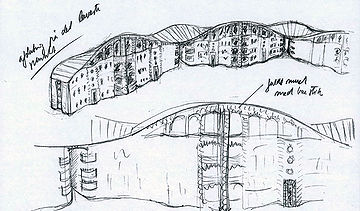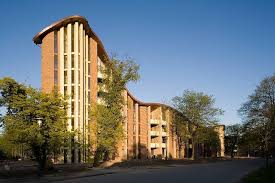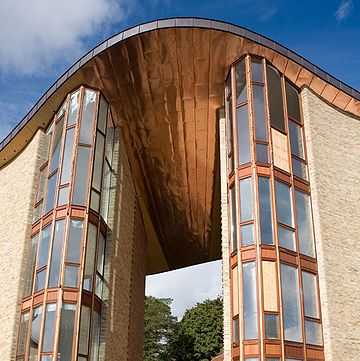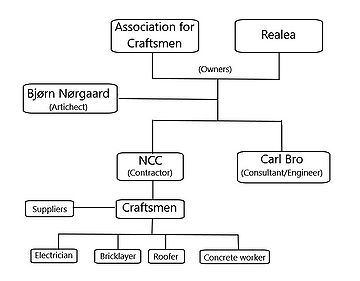Lean Construction on Bispebjerg Bakke
Developed by Christina Diget Christiansen
The project, Bispebjerg Bakke, is called one of the most amazing building projects in Denmark in recent times because of the complicated design and building components. It was a project where the architecture, the craftsmanship and the use of materials was tested, but because of the use of the management tool Lean Construction, was the building project more efficiently and ended up being cheaper than first expected, even though the standard of the materials was high and there were not compromised[1].
The building is design by Bjørn Nørgaard, a Danish sculptor, which formed the building in clay inspired by music, and then handed it over for the architect firm Boldsen & Holm. They started building in 2004, and was done in 2006, where 135 different apartments spread over 11 houses were ready for relocation. Today the buildings adorn the area around Bispebjerg in the northenwest area of Copenhagen and winds like a big snake through the landscape, to eventually rise from a 4 storey building, up to a 7 store in the end. The idea was to deal with the classic apartments-blocks in the area, and build something spectacular, but keep the design in the traditionally way with red and yellow bricks, too follow the colors of Bispebjerg church and the Hospital[2].
The challenge for this construction was to build the curved copper roof and the masonry work because of the curved façades, designed in different forms and colors – yellow on one façade and red on the other facade. No building like this was never built before in Denmark, so the craftsmanship got a big and complicated job.
Contents |
Context: Bispebjerg Bakke as en experiment
The ambition with Bispebjerg Bakke was, through the combination of art, architecture and craftsmanship, to build a beautiful and durable housing development, which should be in harmony with the surroundings and the landscape. The idea came at a meeting between the sculptor Bjørn Nørgaard and the President for the Association for Craftsmen in Copenhagen Klaus Bonde Larsen in 1997 – they both had a vision about building with quality materials that last almost forever, combined with the idea of that art should affect the society and that the surroundings – here the building – should have influences on our joy of life[3].. Realea and the Association of Craftsmen supported this idea and agreed to be behind this project.
“Now we are going to build a house, that the industry can’t build.” quote Bjørn Nørgaard[4].
The project ended up consisting of 135 apartments spread over 11 buildings, where the special copper roof combines the buildings. Most of the apartments are built in two or three level to provide a unique and luxury space feeling, and every apartment is without any right angels in the living- and bedrooms, because of the curved facades. Everything is custom-made for this special case, and there is nothing like this anywhere else.
The project became a partnering-case, which enabled the different contractors to contribute each with their competencies at the optimal time in the process to optimize the building in the best given way. It also meant that the contractors were find in the early stages to help realizing the building and make the ‘art sculpture’ to a real home. The project took 2 years to complete, from 2004 to 2006, with a cost of nearly 20.000 kr. peer m2, which is almost twice as much as normal building projects, and involved 28 bricklayers to only the masonry work when it was busiest.
Challenge
The overall challenge with this project was to transform Bjørn Nørgaards sculpture into an actual building with apartments that could be rented out. The transformation of a piece of art into something more tangible and truly, was a challenge for both the architects and the engineers, but later also the craftsmen.
Not only should the facades curve through the landscape, but the roof should also curve and in the end rise from 4 floors to 7 floors, like a snake raises his head into the sky. This was a big challenge because materials for roofs are all straight, and not even a bit curvy. The challenge was the same with the facades – no fabrics for concrete elements or even masonry bricks make curved elements as standard, and there were no similar building projects in Denmark that could be learned from.
All the curved lines meant that the facades should consist of 88 different specialized curved bricks – 44 in yellow, and 44 in red. And beyond that, the bricklayer should keep on track of all the different bricks and handle them on the scaffolding[5].
The engineers from Carl Bro were skeptical when they were presented to the idea of the alternative building with curved shapes, and the Chief Engineer from the company stated: “When we were presented to this project, our reaction was that it could not be done. And most of the engineers was talking about to redo it so that the house had straight walls and flat roof"[6].
It was not the intention to redo the project to something easy and normal, but Carl Bro agreed on the project anyway. As in many other projects it was in the end the money who has the last word, and in this case, it was also the money who controlled the solutions. From start the idea was to build the whole building of bricks, both the inner- and the outer walls, but when the price on that came from the bricklayer, the owners and Bjørn Nørgaard was forced to find another solution, without changing the main idea and the overall look. Because of the way of working on this project with a partnership agreement between the contractors, the different contractors participated actively with different solutions to the various issues to find a better price and a durable solution that still followed the main ide as closely as possible.
Partnership
Partnership is a type of business organization where two or more companies/individuals collaborate in a project, which is based on dialog, trust, honesty and an early involvement of all parties. The project is implemented with a common goal, with shared activities and a common interest in the economy. Not every partner is necessarily involved in the management and day-to-day work, but everyone in the partnership share their nonleague and resources to get the best out of the project[7].
Partnership engage to implement the philosophy Lean in this case, which in the building industry is called Lean Construction. Lean Construction is a “way to design production systems to minimize waste of materials, time and effort in order to generate the maximum possible amount of value” [8].
The priority for all construction projects is to:
- Keep work flowing so that the parties are always productive installing product
- Reduce inventory of materials and tools
- Reduce costs
The early involvement of contractors and suppliers is seen as a key differentiator for construction projects so called 'best practice'[9].
From start, this project was first meant as a project with many individual craftsmen and no big contractors to manage it all, but even after a couple of meetings between the craftsmen, it went wrong. All the craftsmen were scared that the project would went wrong during the process, so they gave a high price on their contract, so there wouldn’t be any surprises where they could lose a lot of money. With this method, the project would have been a half time more expensive, and the owners couldn’t afford it, so they called NCC (Contractors) to step into the project as main contractor to manage it all.
When NCC was hired, the owners decided to make the project into a partnership between the different parties, where NCC should manage and control the hole team of craftsmen, engineers, architect and the owners. From that on all the parties was collaborating about the project and shared all the nonleague and resources to get the best price and the best results together.
Solution
Partnership enabled the various contractors to be involved very early in the project phase, so that they could influence the process and make incentives for their work. Because of the money situation it was decided that the inner walls should be of concrete elements, but because of the curved forms, it couldn’t be standard elements from the industry, which the architect also from the start was against. So they found a company there should make these special concrete elements with the right curves, so it was all costume made, and actually also cheaper than if the inner walls should have been of bricks.
For the bricklayer, Kim Cordsen was the time in the design phase very important, because he had to plan the brickwork for the curved facades. If his men should build the facades by 44 different bricks, they should be very concentrated, and it would take a lot of time to remember the order and ran up and down on the scaffolding with different bricks all the time. He thought that it could be done easier than the architect has mentioned, so he went home and tried to build a wall with the exact same curves as in the project, and realized that only 4 different bricks could make the same curves. This was much easier for his men to build with, and luckily the architect and the owners liked the idea, and they saved a lot of money by this discovery.
However, the bricklayer Kim Cordsen had another problem. It would still take a lot of time for his men to ran up and down with bricks on the scaffolding, and the scaffolding wasn’t curved, so it would be hard to work on. He knew that the time with all the transport up and down with bricks would cost a lot in time, so he decided to order some lifts instead of scaffolding, so his men could go automatically up and down with bricks, and drive the lift up to a good working height, so they shouldn’t stand in different and awkward positions while building.
The problem with the curved roof was also solved by the contractors, because they found a small company where they could make special curved wooden cassettes prepared only for this project. The wooden cassettes were made on a factory and then transported to the building site and lifted up to the top of the building. With this solution, the craftsmen on the project saved a lot of time and troubles, because the roof was almost done when it came. The only thing the craftsmen should do, was to screw the cassettes together, attach them to the walls and then clothe them with copper.
Although the building was built in a different way than first expected, It have been possible to maintain the connection between the exterior and the interior, as Bjørn Nørgaard and the architect has thought of, because of the industry and the craftsmen to devise the different solutions to the challenges.
Implementation
“A big part of becoming Lean is the culture and attitudes of those who are involved in the processes. Leaders are extremely important in instilling the culture changes into their employees so that their Lean journey can be successful” Citation Megan Johnson, Student Process Improvement Coordinator[10].
Partnership for general construction projects
Partnership and the use of Lean have a big influence on the construction projects today. The advantaged is among others that a partnership can result in a better price for the owners of the project, even though the owners has not been through a price-competition. In a partnership, the prices and the economy is open, which means that the different parties in the partnership can’t hide their salaries and their profits, so the theory is that you get the best possible prices on a project by doing partnership.
When the partnership agreement is chosen in the early stages of the project, for instances in the design phase or before, the different craftsmen have greater influence on the work process and the execution of the work, and they can plan their work more productive with the other parties.
In general, there is a greater advantage of being more parties/craftsmen in a partnership agreement, because the more specialists in a project the more knowledge, and the more cooperation. The negative site on this is that the coordination between many parties can be tricky and the owners has to consider which of all the parties they will have in the project management team, because not all can be in the leading team.
For the project on Bispebjerg Bakke the use of partnership agreement and Lean tools meant that the project could be built easier, more productive and less expensive than first expected. It was a great advantage that the different craftsmen worked together to get the best result. however, it wasn’t a project that was cheap and the owners did not compromise on the quality of the materials, but the cooperation between the craftsmen and the contractor saved the owners for a lot of money, because the process of the building phase was ‘lean’ and they didn’t waste time or materials.
With this project the approach have been that if the craftsmen were excited about the project and had some influence too, then it would be seen it the result. This means that if the worker is glad for his job, then the job will be perfectly done[11]. A big part of this is the culture and attitudes of those who are involved in the process, where it in this case was Lean the leaders were trying to implement. Bjørn Nørgaard and the owners has to “sell” the idea to the contractors so the contractors could be as enthusiastic as them, so the contractors could convey this optimism to their workers/craftsmen.
Annotated Bibliography
- Høegh Østergaard, Poul. 2009. "Bedre Byggeprocesser - Femten trimmede lærestykker fra aktuelt dansk byggeri"
- A book about different case studies in Denmark, where Lean Construction is implemented in the project. From page 56 to 65 is the case about Bispebjerg Bakke described with focus on the bricklayers work and the advantages with the use of Lean Construction.
- Kierkegaard Cian, Signe. 2007. "Bispebjerg Bakke - Historien om Slangen på Bispebjerg"
- A danish book about the hole history about Bispebjerg Bakke from start to end and the ideas about the project.The book also describes the different parties in the case, and there is also some interviews with the people living in the building today.
- Erhvervs- og Bygestyrelsen. 2006. "Vejledning i partnering"
- A guide with information and details about partnership and the use of it. This source is used to get information about partnership, was it is, and which pro and cons there is with it.
References
- ↑ Østergaard, P.H. (2009). Bedre Byggeprocesser. ISBN 978-87-993539-0-3
- ↑ Østergaard, P.H. (2009). Bedre Byggeprocesser. ISBN 978-87-993539-0-3
- ↑ Realdania, link: https://realdania.dk/projekter/bispebjerg-bakke
- ↑ Cain, S. K. (2007). Bispebjerg Bakke - historien om slangen på Bispebjerg.
- ↑ Østergaard, P.H. (2009). Bedre Byggeprocesser. ISBN 978-87-993539-0-3
- ↑ Cain, S. K. (2007). Bispebjerg Bakke - historien om slangen på Bispebjerg.
- ↑ Erhvervs- og Byggestyrelsen. Vejledning i Partnering
- ↑ Koskela et al. (2002). Foundation of Lean Construction
- ↑ Koskela et al. (2002). Foundation of Lean Construction
- ↑ Johnson, M. (2011). https://blogs.mtu.edu/improvement/2011/08/08/78/.
- ↑ Cain, S. K. (2007). Bispebjerg Bakke - historien om slangen på Bispebjerg.



